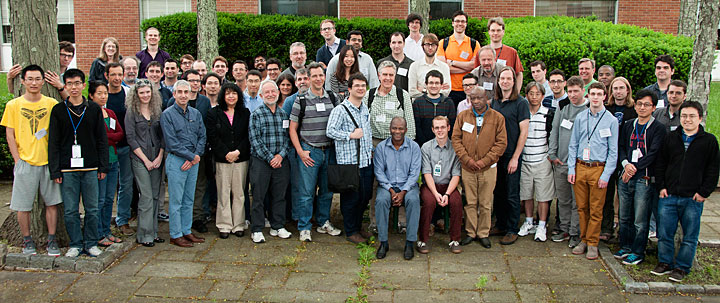Dark Interactions Workshop Brings Global Physicists to Brookhaven Lab
August 11, 2014
 enlarge
enlarge
Nearly 80 physicists — representing experiments from laboratories including Thomas Jefferson National Accelrator Facility, the Large Hadron Collider, the Mainz Microtron, SLAC National Accelerator Laboratory, KEK, and universities involved in other dark particle detector experiments — attended the Dark Interactions Workshop at Brookhaven National Laboratory in June 2014.
For three days in June, physicists from around the world came together at the U.S. Department of Energy’s Brookhaven National Laboratory for the inaugural physics workshop “Dark Interactions: Perspectives from Theory and Experiment,” chaired by Brookhaven physicist Ketevi Assamagan. He jointly organized the workshop with Brookhaven physicist Hooman Davoudiasl and Stony Brook University assistant professor of physics Rouven Essig.
The goal of the workshop was to review and discuss the theoretical context as well as the status and future of the searches for dark sector particles, such as dark vector bosons, and the implications for dark matter.
It's hard to believe dark matter is an idea that's 80 years old. We still don't' know what dark matter is.
— Professor David Brown, University of Louisville
“We hope to continue this meeting in the years to come. We gain a lot by sharing ideas between theorists and experimentalists,” Assamagan said. Nearly 80 physicists attended the workshop to hear presentations that covered a range of topics on the frontier of new physics: the theories and experiments trying to track down dark matter, the mysterious substance that neither emits nor absorbs light, but is theorized to comprise nearly 27% of the cosmos.
So far, despite the tremendous amount of evidence for the existence of dark matter, nobody knows its identity; but if anyone is going to devise a way to determine its makeup, it could be one of the physicists in attendance at the workshop. Over the course of several days, they discussed theoretical motivations for the search for dark matter, and several experiments already looking for the mystery matter, including:
- The DarkLight, HPS, and APEX experiments at Thomas Jefferson National Accelerator Facility;
- The CMS, ATLAS, ALICE and LHCb experiments at the Large Hadron Collider in Geneva, Switzerland;
- The A1 collaboration at the Mainz Microtron;
- Dark photon and low-mass Higgs searches at the BaBar detector at the SLAC National Accelerator Laboratory;
- The Belle Collaboration at KEK
- The PHENIX experiment at Brookhaven National Laboratory
- The Muon g-2 experiment
- The Axion Dark Matter Experiment at the University of Washington
- LHC experiments, namely ATLAS, CMS, ALICE and LHCb also contribute to the searches for Dark Matter. Ketevi Assamagan (BNL) and Oliver Keith Baker (Yale University) are working on some of the ATLAS analyses that may provide clues into the nature of Dark Matter.
“It’s hard to believe dark matter is an idea that’s 80 years old,” said Professor David Brown of the University of Louisville. “Of course, we still don’t know what dark matter is. But colliders let us search for dark particles.”
"Understanding the nature of dark matter poses one of the most urgent problems for our fundamental description of the Universe,” Davoudiasl said. “Interactive meetings, like DI2014, allow us to share various points of view on the scope of theoretical and experimental opportunities, as well as challenges, that lie ahead in the quest to uncover the properties of dark matter."
The attendees shared results from experiments all over the world, with tantalizing hints at the nature of dark matter. And as they continue this search, coordination across disciplines and national borders remains key to collaboration.
“An enormous amount of progress has been made over the last few years in the search for dark matter and dark forces,” Essig said. “All of us hope that the current generation of experiments will be successful at finding new physics.”
2014-4960 | INT/EXT | Newsroom









